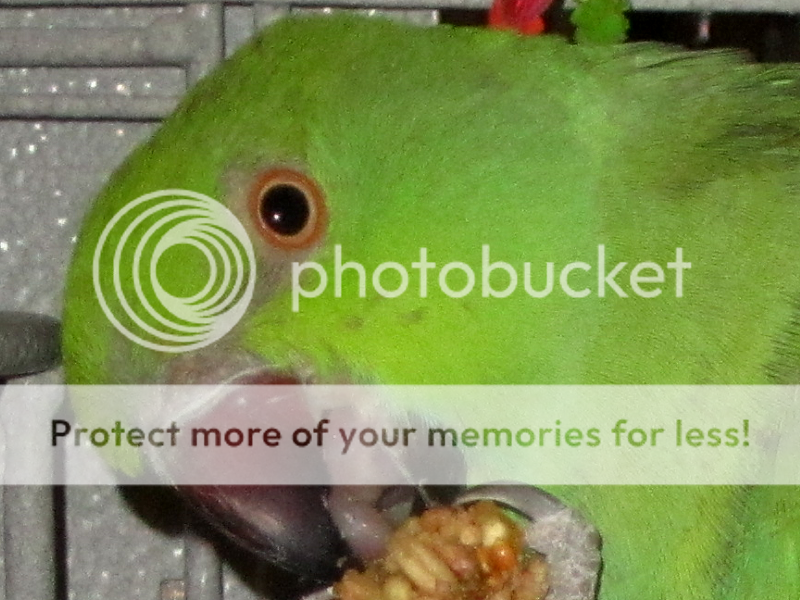Aspie_Aviphile
New member
- Jul 19, 2018
- 145
- 13
- Parrots
- Biddy, budgie, departed 2nd Sept 2018; Bo, Indian Ringneck, 5th Feb 2020; </3
I've had Bo nearly six months now and since becoming tame, he seems to act more like the typical descriptions of the African Ringneck or the Abyssinian Ringneck than the IRN:
He's non-vocal most of the day interspersed with three or four chatty periods of inoffensive vocalisations; enjoys showering with me, is affectionate, is gentle (allowing for the trial and error involved in learning the sensitivity level of different parts of a human), and has not been aggressive towards me since he lost his fear, giving fair warning before nips and applying progressively more pressure in proportion to how much I ignore the first nips (in those situations where he respecting his wishes is not an option as the thing he's complaining about just needs to be done). The only trait I've noticed that's more typical of the IRNs among the different ringneck subspecies, is that he'll eat anything.
I don't have much faith in the information given by the pet shop that sold him to his first home, like subspecies. I don't mean that they've been deliberately deceptive, just that it seems plausible from their internal communication and record-keeping issues that they could believe they sold IRNs last year when they actually sold ARNs.
I suppose if I want to be certain I'll have to take him to a vet for testing but I don't want distress him with a vet visit unless really necessary, so in the meantime I'm wondering what all you other ringneck parents think about his likely subspecies given his appearance in these videos and what I've described.
I want to show him from a few different angles doing different things in different light conditions but YouTube isn't processing one of the videos so I can only post these two for now. It's amazing how many different sizes and hues the same bird can appear to be on camera. For scale, I'm 5"1 and my hands are the size of most 7 year olds' hands. Please pardon the baby talk, I can't help it around him.
[ame="https://www.youtube.com/watch?v=iHBtoSGDnHY"]https://www.youtube.com/watch?v=iHBtoSGDnHY[/ame]
[ame="https://www.youtube.com/watch?v=Mm8RfqmZ73w"]https://www.youtube.com/watch?v=Mm8RfqmZ73w[/ame]
He's non-vocal most of the day interspersed with three or four chatty periods of inoffensive vocalisations; enjoys showering with me, is affectionate, is gentle (allowing for the trial and error involved in learning the sensitivity level of different parts of a human), and has not been aggressive towards me since he lost his fear, giving fair warning before nips and applying progressively more pressure in proportion to how much I ignore the first nips (in those situations where he respecting his wishes is not an option as the thing he's complaining about just needs to be done). The only trait I've noticed that's more typical of the IRNs among the different ringneck subspecies, is that he'll eat anything.
I don't have much faith in the information given by the pet shop that sold him to his first home, like subspecies. I don't mean that they've been deliberately deceptive, just that it seems plausible from their internal communication and record-keeping issues that they could believe they sold IRNs last year when they actually sold ARNs.
I suppose if I want to be certain I'll have to take him to a vet for testing but I don't want distress him with a vet visit unless really necessary, so in the meantime I'm wondering what all you other ringneck parents think about his likely subspecies given his appearance in these videos and what I've described.
I want to show him from a few different angles doing different things in different light conditions but YouTube isn't processing one of the videos so I can only post these two for now. It's amazing how many different sizes and hues the same bird can appear to be on camera. For scale, I'm 5"1 and my hands are the size of most 7 year olds' hands. Please pardon the baby talk, I can't help it around him.
[ame="https://www.youtube.com/watch?v=iHBtoSGDnHY"]https://www.youtube.com/watch?v=iHBtoSGDnHY[/ame]
[ame="https://www.youtube.com/watch?v=Mm8RfqmZ73w"]https://www.youtube.com/watch?v=Mm8RfqmZ73w[/ame]
Last edited:






